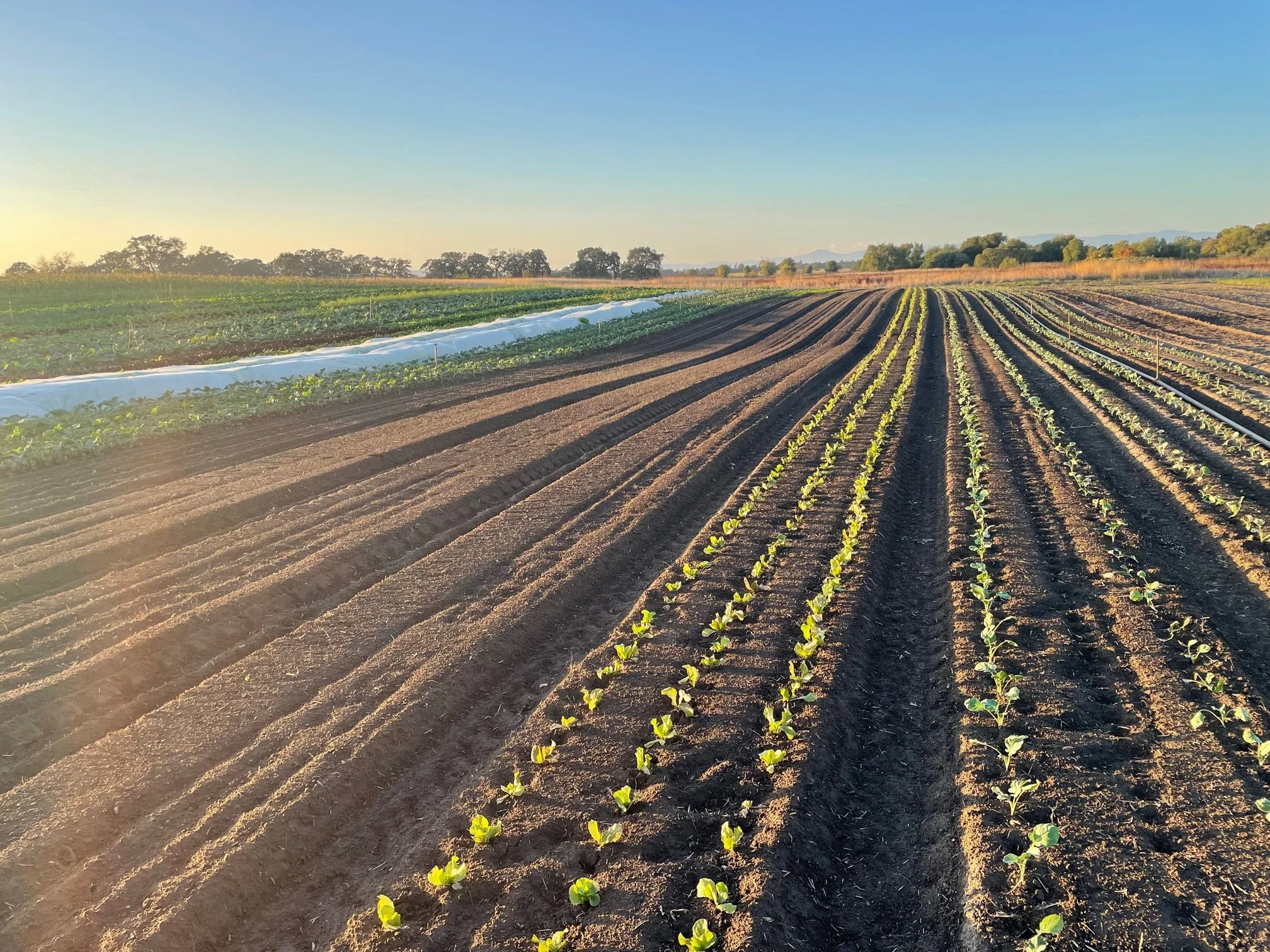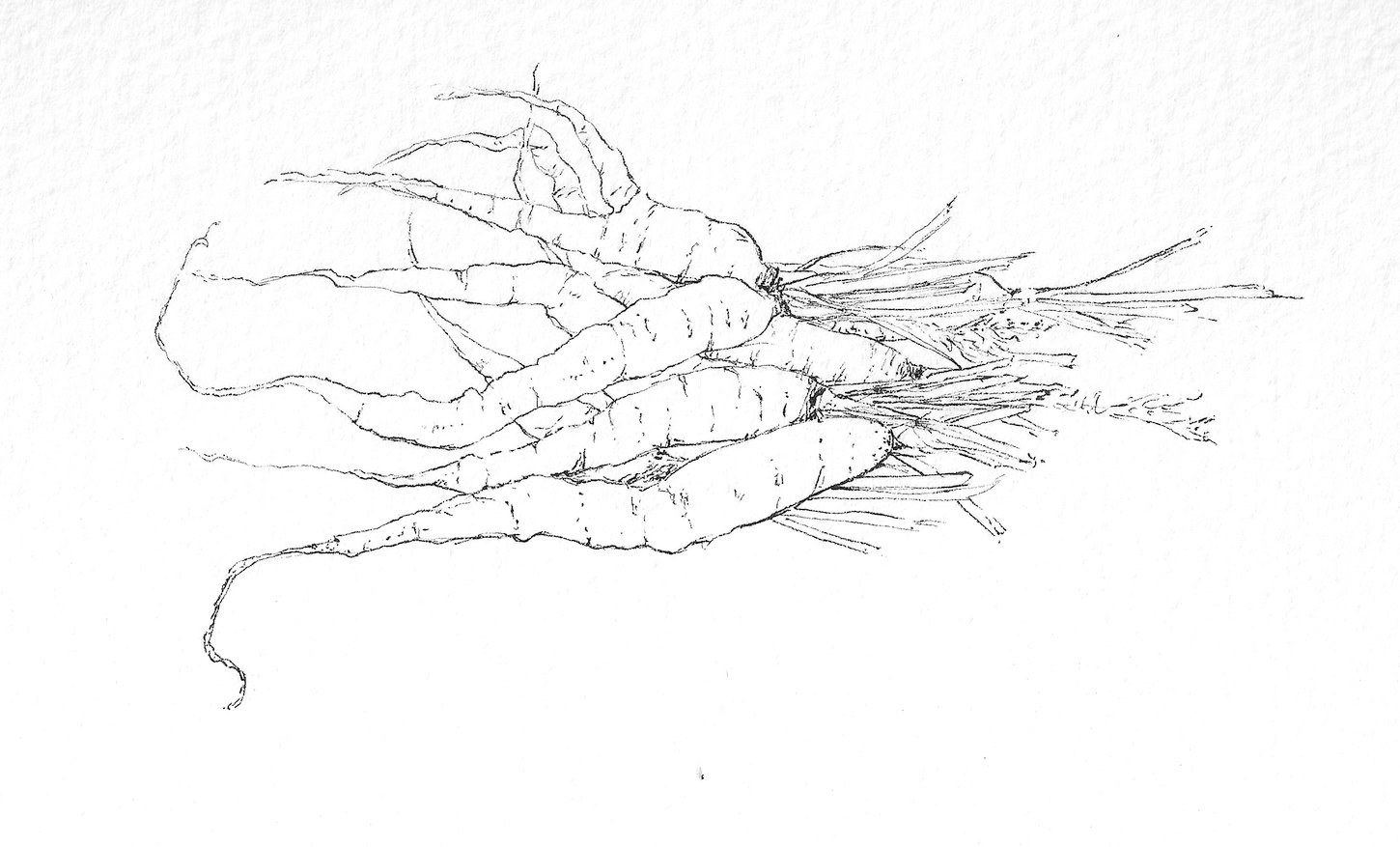THIS WEEK’S HARVEST
Mustard Mix, Cegolaine Gem Lettuce, Bluerock Romaine Lettuce, Red Butter Lettuce, Easter Egg Radishes, Carrots, Sweet Corn, Red Ace Beets, Farao Cabbage, Eggplant, Striped Armenian Cucumbers, Lemon Cucumbers, Costata Romanesco Zucchini & Patty Pan Squash, Fresh Torpedo Onions, Early Girl & Heirloom Tomatoes
U-PICK
Albion Strawberries | 3 pints per share: 🚨 ATTENTION! The areas near the entrances are pretty picked on, don’t forget to branch out to the back areas to find the jack-pots!
Padrón Peppers | 2 pints per share | See Week 4’s Newsletter for tips on how to prepare these delicacies.
Shishito Peppers | 3 pints per share | See Week 4’s Newsletter for tips on how to prepare these delicacies.
Cherry Tomatoes | 2 pints per share
Amethyst Green Beans | 1 pint per share
Jalapeños | 2 peppers per share | To find the hottest ones, look for “checking”, the delicate cracks in the skin that indicate the pepper has aged into its heat.
Herbs: Italian, Purple and Thai Basil, Dill, Tulsi, Chamomile, Parsley, Onion Chives, Garlic Chives, Tarragon, Thyme, Oregano, Marjoram, Culinary Sage, Lemon Balm, Lemon Verbena, Vietnamese Coriander, Shiso (Perilla), Catnip, Pineapple, Sorrel, Assorted Mints & Husk Cherries!
Flowers!
HARVEST NOTES
Husk Cherries: Also called Ground Cherries or Cape Gooseberries, these little treats look like tiny tomatillos and taste a bit like orange juice. Ripe husk cherries have dry, tan-colored papers and a golden berry inside, and are most easily found by looking on the ground under the plant. Find a few to snack on in the Northern side of the garden, near the basil and sunflowers.
Ripe husk cherries and Aisling with a load of fresh Torpedo Onions.
LEMON DILL SAUERKRAUT
We have some beautiful heads of cabbage in the share this week, perfect for making sauerkraut! Here is our favorite garlicky dill kraut recipe from the book Fermented Vegetables by Kristen and Christopher Shockey.
Note: if you’ve felt intimidated by making kraut, don’t worry! It’s basically just chopping and salting cabbage, then keeping it submerged in a brine. That, plus a couple days of waiting is all you need to make exceptional sauerkraut.
(Yields about 1 gallon of kraut)
about 6 pounds cabbage (2 small heads or one large one)
1 1/2-2 tablespoons unrefined sea salt
4 tablespoons lemon juice
1-2 tablespoons dried dill or about 1/4 cup fresh dill, according to taste
4-5 cloves of garlic, finely grated
To prepare the cabbage, remove the coarse outer leaves. Rinse a few unblemished ones and set them aside. Quarter and core the cabbage, thinly slice, and transfer to a large bowl.
Add the dill, lemon juice, and 1 tablespoon of the salt and, with your hands, massage it into the leaves, then taste. You should be able to taste the salt without it being overwhelming. Add more salt if necessary. The cabbage will soon look wet and limp, and liquid will begin to pool. At this point, add the garlic. If you've put in a good effort and don't see much brine in the bowl, let it stand, covered, for 45 minutes, then massage again.
Transfer the cabbage to a crock or 2-quart jar, a few handfuls at a time, pressing down on the cabbage with your fist or a tamper to work out air pockets. You should see some brine on top of the cabbage when you press. Leave 4 inches of headspace for a crock, or 2 to 3 inches for a jar. Top the cabbage with one or two of the reserved outer leaves. Then, for a crock, top the leaves with a plate that fits the opening of the container and covers as much of the vegetables as possible; weigh down with a sealed, water-filled jar. For a jar, use a sealed, water-filled jar or ziplock bag as a follower-weight combination.
Set aside the jar or crock on a baking sheet to ferment, somewhere nearby, out of direct sunlight and cool, for 4 to 14 days. Check daily to make sure the cabbage is submerged, pressing down as needed.
You can start to test the kraut on day 4. You'll know it's ready when it's pleasingly sour and pickle-y tasting, without the strong acidity of vinegar; the cabbage has softened a bit but retains some crunch; and the cabbage is more yellow than green and slightly translucent.
Ladle the kraut into smaller jars and tamp down. Pour in any brine that's left. Tighten the lids, then store in the refrigerator. This kraut will keep, refrigerated, for 1 year.
MADHAR JAFFREY’S BEET DIP
From World Vegetarian
This bright magenta dip is easy to make and easy to eat! It’s luxuriously silky, with an earthy sweetness that’s perfectly balanced by the richness of the walnuts and sharpness of garlic and vinegar. Serve it as a visually-stunning appetizer with crudités, or slathered on crusty bread.
1 good sized red beet (about 6 oz) or two smaller ones
4 T chopped walnuts
1 slice stale white bread (optional)
1 clove garlic, coarsely chopped
6 T olive oil
2 T red wine vinegar
1/2 t salt, or to taste
Boil the beet in its skin until soft, about 40 minutes. Drain, peel, and let cool. Chop coarsely. Throw everything in a food processor and blend until smooth.
Last Friday we said farewell to our dear Hippie Dust (aka The Goat, aka Tristan) as he heads to law school in Colorado! Tristan held it down in so many ways on the farm and in the fields and we will miss him!
VOLUNTEERING ON THE FARM!
Feel like getting some dirt on your hands and working in the garden with us? CSA member and former veggie farmer Rose Brink Capriola is generously coordinating volunteer meet-ups! Send us an email if you’d like to get on her volunteer email list. Kids welcome!
FARMER’S LOG
AUGUST EMPTINESS
At this time of year it is hard to find the headspace for a thoughtful Farmer’s Log — the steady rhythm of the bulky harvests drowns out softer notes of reflection.
To sneak in planting, seeding, and weeding in the margins of harvest your only thoughts are farm thoughts, your only feelings are farm feelings. You must remain disciplined, focused… you can’t miss a beat (no pun intended).
This week, while the harvest share gets more summery, we turned the fields another notch towards fall. We transplanted over 2,000 ft of romanesco, chicories, and lettuce. Asa seeded our fall daikon and watermelon radishes. We started tapering the water down on our bulbous onion crop. And we started cultivating our 6,400 ft of fall carrots — now two inches tall and unfurling their first true leaves.
Wednesday morning transplanting for autumn and winter shares. We’re Getting down the last few big transplantings of the year!
It’s a strange feeling, this time of year: Our internal lives, our emotions, dreams, and whimsies — feel far away, shoved aside by the harvest and urgent needs in the field — but at the same time we never feel more full.
There is a sort of innocence, a fullness, in being so busy as to be empty.
Then, the swelling of the corn stalks can you lift you up to the eaves. The heat is your sorrow. The flowering potatoes are your whimsical thoughts. And the little things — a good sip of coffee, a crew mate’s joke, a good harvest — can fill you up to the brim.
See you in the fields,
David
CSA BASICS
Drive slow! Please drive slow on Cooper Rd. and in our driveway / parking lot area. Kids at play!
No dogs: Unfortunately, dogs are not allowed on the farm.
What time is harvest pick-up?:
Saturday harvest pick-ups run from 9:00 am - 2:00 pm
Tuesday harvest pick-ups will run from 1:00 pm - 6:00 pm
Oriented members can come to the farm any time, 7 days a week, sunrise to sunset, to u-pick and enjoy the farm.
Where is the farm? The member parking lot is located at 1720 Cooper Rd., Sebastopol, CA 95472.
Where is the food? The produce pick-up barn is just to the right of the solar panels and above our big greenhouse. You can’t miss it!
2024 CSA program dates: Our harvest season will run from Saturday, June 15th through Tuesday, December 10th this year.













